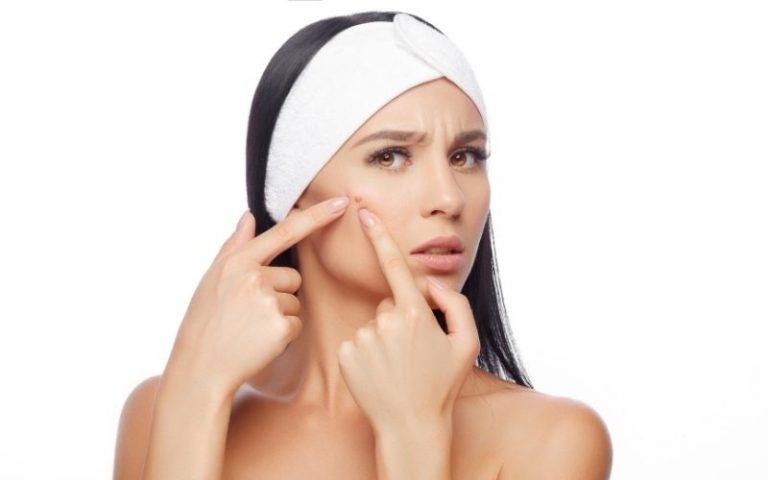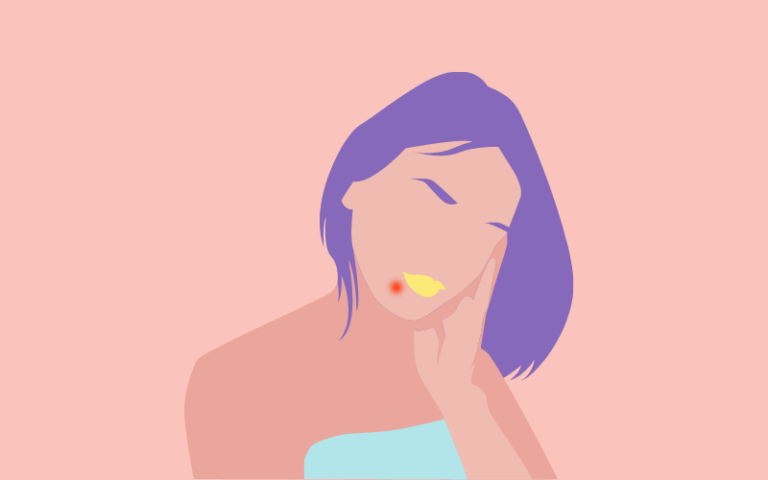Getting Rid of Closed Comedones: Everything You Need To Know

Having oily skin ain’t easy! Between a forehead shiny enough to see your reflection to feeling like a greaseball, it seems hopeless trying to figure out how to de-slick the skin.
The worst part?
You can get tiny little bumps — AKA: closed comedones.
Most of us with closed comedones will always be prone to them, which means we have to stay on top of our skin to keep those pesky pimples in line. The end game for any breakouts is to get the skin in a healthy and balanced cycle.
The good news is it’s not as hard as it may seem! You may already have products that can help.
It’s easy to feel embarrassed and want to hide away when your skin looks bad. With a few changes or a trip to the doctor, you can kiss oily skin and tiny bumps bye-bye!
How to know if you have closed comedones
Closed comedones are a bit different from other bumps and pimples on the face because wait for it — they’re closed!
They’re more commonly known as whiteheads and are a type of comedonal acne that can happen to anyone. If you’ve ever tried squeezing one of these pimples, you’ll notice they’re filled with stickiness and pus!
Appearance
Closed comedones look like little bumps on the surface of your skin. Not to be confused with a blackhead or other forms of acne, they’re not open-faced like your typical blemish.
They don’t usually hurt the way inflammatory acne does or show up as large lesions or pustules, but this doesn’t mean they aren’t an annoying experience for those of us that have them.
The difference between open comedones (better known as blackheads) and closed comedones is whether or not the pore is exposed to air. Blackheads occur when the melanin found within the skin cells and excess oil produced from the pore oxidizes after being exposed to air, appearing black.
Whiteheads on the other hand are never exposed. The pore opening remains closed and traps the sebum within, creating a white and pus-filled bump.
Closed comedones can happen anywhere on the body, but they usually pop up on the area of the face (usually the forehead), neck, chest, and back area.
The oil glands on the forehead and cheek area of the face are most likely to get plugged with excess sebum. They can appear alone or in little clusters.
So what causes these bad boys and how can we get rid of them?
What causes closed comedones?
Since a closed comedo (singular of comedones) happens when a pore opening or hair follicle gets clogged with oil, it all comes down to sebum production of the skin and the buildup of dead cells.
This in turn creates debris that clogs the pores and shows up as small bumps on the top layer of skin.
For those of us that have a skin type that’s more oily than others, we can blame our genetics!
For those of us prone to being oily, it’s important to properly cleanse the surface on the skin of the face.
If we don’t wash our face then the accumulation of product buildup and excess oil creates an unending cycle filled with stickiness and disappointment!
External factors
There are also less known reasons comedonal acne and clogged pores can happen. Certain food groups can cause oil production to go into overdrive.
The main culprits are dairy, sugar, and fat. Luckily these can easily be remedied.
If you suspect one of these is causing them, cut dairy, sugar, or fat out one at a time from your diet for 2-4 weeks and see if your skin improves.
If you live in an environment with a lot of humidity, skin can be stickier and feel oily, both of which lead to whiteheads.
Those who suffer from skin picking or squeezing the surface of the skin are predisposed to closed comedones.
Smokers are also more prone to comedonal acne.
Sometimes they can also arise from professional treatments such as laser peels or chemical peels which can cause the moisture barrier of the skin to be compromised, leading to irritation and an imbalance of oil production.
Don’t let this get you down, though. No matter the reason, there are plenty of things you can do!
Typical age range
Those of us going through major hormonal changes such as puberty are the most likely age range at which closed comedones happen.
Whiteheads are very common if you’re an adolescent or teenager since the skin’s oil glands and hair follicles increase more sebum during this period, making it more likely a closed comedo will pop up on the skin’s surface.
For those of us who are no longer teens, pregnancy and other hormonal changes may be the reason for an abundance of closed comedones.
From inflammatory acne to lesions, acne vulgaris (the fancy word for acne) caused by a hormonal imbalance can happen to happen at any age.
If you’re aren’t going through any of these conditions, then it’s most likely because your skin is naturally oily.
In this case, it’s important to optimize your skincare regimen and use products with ingredients that are non-comedogenic, or won’t cause closed comedones. Be sure to use a face moisturizer and hair products that touch the face (such as hair gel) that are non-comedogenic.
These types of products are the most likely to contain ingredients that clog pores and hair follicles.
General skincare advice for comedonal acne
Before we get into specifics, let’s talk about the general things to keep in mind.
Wash your face twice per day
You’re more likely to have more oil and skin buildup at the end of the day, so it’s especially important to use a good cleanser and remove dead cells when you wash your face before bed.
When we sleep is when our skin cells go through the most cell turnover, so get your face primed and ready to wake up fresh!
Cleansing the face and jawline properly of any dirt, residue, makeup, and sunscreen that clog the oil glands is important.
Just because you don’t wear makeup doesn’t mean you can skip washing your face — you still have buildup!
If you don’t wash the skin’s surface with a cleanser that thoroughly breaks up the day’s debris then you’re not going to see an improvement of those pores!
Sunscreen
Sunscreen is important no matter what skin changes you’re going through, even if you have perfect skin.
Oily skin can be a bit tricky.
Choose a sunscreen that’s oil-free or labeled as non-comedogenic. These sunscreens are specially formulated with a mixture of ingredients for those suffering from sebaceous glands that produce more oil.
Moisturize!
Just because your skin is oily or and doesn’t feel dry doesn’t mean you should skip a moisturizer.
After cleansing the face use a moisturizer or lotion that’s oil-free and marketed for oily skin. A lightweight lotion will keep the skin hydrated without contributing to more oil. Avoid any face oils or heavy creams.
Trust me, creating a skincare regimen with over-the-counter products that work for you and not against you will keep your skin in check and make your life much easier.
Natural ingredients as a home remedy
Other approaches to consider if you’ve tried the above options or want to incorporate other methods are natural remedies.
When used in conjunction with the above they can make a powerful team for fighting whiteheads!
Tea tree oil: A common antibacterial and antimicrobial ingredient used as an acne treatment. When it’s applied topically as a spot treatment, it can fight acne and closed comedones.
Witch hazel: A mild astringent and when used as a toner works to dry up excess sebum. Use after washing the face and be sure to follow with moisturizer. Witch hazel works for acne on the body as well!
Turmeric: An antibacterial and anti-inflammatory with tons of antioxidant properties. It can be made into a paste and used as a topical mask that helps reduce clogged pores and brighten the skin.
Tamanu oil: A lesser-known natural remedy with studies that have shown its efficacy in wound-healing and skin regeneration properties that work to fight acne.
A home remedy may be right for you if you already have some of these things on hand or want to add another treatment to your skin regimen.
Other treatments
We talked about over-the-counter treatments and non-comedogenic ingredients to incorporate, so let’s dive into the specifics!
Acne-fighting cleansers
We discussed how it’s important to wash your face 2x a day, so what type of cleanser should you use?
Cleansers that fight blemishes will typically work to fight any form of acne, which includes whiteheads. Even better, they’re commonly found in the drugstore and easily accessible.
“Acne-fighting” simply means a product has active ingredients that work to break up oil, bacteria, and dead skin cells to reveal clean and clear skin.
Types of acne-fighting cleansers
So which acne-fighting cleanser is right for you?
To start, look for a face wash with salicylic acid or benzoyl peroxide.
Salicylic acid is a beta hydroxy acid that is oil-soluble, meaning it hits oil right at the source to break it up. It’s a chemical exfoliant that sloughs off dead skin cells with use.
Benzoyl peroxide is an antibacterial ingredient found in face washes and spot treatments that can be very drying but also very powerful.
If using a benzoyl peroxide face wash, wash with it once daily and be sure to follow up with a good moisturizer.
Remember — just because you’re trying to fight excess oil production doesn’t mean you can skip hydration!
Add a gentle otc exfoliant to your routine
Chemical exfoliants have active ingredients that include alpha hydroxy acids and beta hydroxy acids.
We talked about salicylic acid above, but don’t be afraid to give AHA’s a try.
These types of chemical exfoliants include lactic acid and glycolic acid, which are water-soluble and more gentle on the skin than oil-soluble salicylic acid.
You can also look for a mask or exfoliant with a combination of these acids that comes in a higher percentage than an everyday face wash.
Start slowly to acclimate your skin and make sure you aren’t irritating — you don’t want to cause a more severe case of inflammation.
Gentle physical exfoliants used several times a week in addition to your daily acne-fighting cleanser will help with closed comedones as well. As opposed to a chemical exfoliant, they have physical ingredients that work to rub the skin and cause friction that sloughs off dead cells and breaks up oil.
Professional extractions
It’s never a good idea to pop or squeeze anything on your skin’s surface by yourself.
You can cause further inflammation and turn those tiny bumps into angry red pimples with swelling that turn to scars, making them much worse!
If you feel the urge to pop, getting a professional extraction is your best bet if you have stubborn closed comedones or simply want to get rid of them faster. You can add these in weekly, monthly, or as recommended by a professional.
Extractions should be done by a licensed professional.
They will have tools specifically made to target whiteheads and will be able to spot closed comedones and what may be another type of acne.
Extractions are done by steaming the face with warm water or a warm washcloth and squeezing the pore opening to pull out the stickiness, dead skin cells, and other gunk.
The professional will then sanitize the face to get rid of the bacteria and pus and apply a moisturizer.
See a derm or doctor
In some cases, you may need a dermatologist to give you a prescription medication such as oral antibiotics, topical creams, birth control pills, or isotretinoin therapy.
If your closed comedones aren’t improving, don’t get frustrated!
This just means it’s time to see a professional.
Another advantage of seeing a doctor in the dermatology field is that you will be able to get a prescription at higher concentrations approved by the FDA than over-the-counter products.
Treatments you can expect from a dermatologist
The first step for women may be birth control pills. They are the best way to fight severe acne, especially if hormonal acne is suspected.
These are known to be a long-term solution for anything from little bumps to severe cases of acne vulgaris.
Oral contraceptives
Oral contraceptives regulate the hormone levels, which as we all know by now cause all sorts of icky skin problems.
They can help by controlling the excess oil that the sebaceous glands produce.
Oral antibiotic
Another effective way to fight closed comedones is an oral antibiotic.
Minocycline, erythromycin, and tetracycline are all long-standing medications that fight not only whiteheads but blemishes and cystic acne as well.
Vitamin A derivatives
Derivatives of vitamin A are another long-term prescription and topical therapy that fight acne. They are known as topical retinoids.
You may have heard of these in otc treatments referred to as retinol.
Tretinoin (brand name Retin A) adapalene (brand name Differin), and Tazorac are a few of the types of professional retinoids used topically and come in a cream or gel.
These derivatives of vitamin A are intense — they can cause redness and dryness at first, so be sure to get your skin used to them if you want to see a noticeable change in the long run to fight severe acne and inflammatory lesions such as pustules and even cysts.
Isotretinoin
Isotretinoin, also known as Accutane, is a prescription retinoid in pill form that’s a strong treatment plan prescribed in severe cases as an effective way to fight acne.
Isotretinoin therapy is not meant to be used indefinitely and comes with many side effects, so be sure to follow your doctor’s advice if taking isotretinoin.
Procedures
A dermatologist can also recommend professional procedures as an effective way to improve the surface of your skin.
Laser therapy done in a dermatology office helps the skin in many ways, not just comedonal acne!
It fights severe cases of dark spots, reduces permanent scarring, and shows a noticeable change after just one treatment.
Summary
Don’t let that stickiness get you sad!
A comedo is more common than you think. Many of the tips here will help with all forms of acne, too. A proper skin routine done regularly will get your skin glowing in no time.
Remember to always start slowly with any topical treatment or medication you decide to go with — it’s important not to cause further irritation and create a lesion that’s worse than the small bumps you had in the first place!
So, what’s the bottom line?
Wash your face twice a day and avoid products that clog the pore opening and hair follicle.
If you have a home remedy, try it!
When in doubt, see a derm who can pull out the big guns — you may need something beyond what you can buy at the counter of a drugstore.
- “Acne.” Womenshealth.Gov, 15 Dec. 2016, https://www.womenshealth.gov/a-z-topics/acne.
- Comedonal Acne | DermNet NZ. https://www.dermnetnz.org/topics/comedonal-acne/. Accessed 14 Jan. 2021.
- Dermatology Procedures – American Osteopathic College of Dermatology (AOCD). https://www.aocd.org/page/DermProcedures. Accessed 14 Jan. 2021.
- Pappas, Apostolos. “The Relationship of Diet and Acne.” Dermato-Endocrinology, vol. 1, no. 5, 2009, pp. 262–67.
- Russell, John J. “Topical Therapy for Acne.” American Family Physician, vol. 61, no. 2, Jan. 2000, pp. 357–65.
- Comedonal Acne: Traditional Treatments, Natural Remedies, and More. https://www.healthline.com/health/beauty-skin-care/comedonal-acne. Accessed 14 Jan. 2021.





